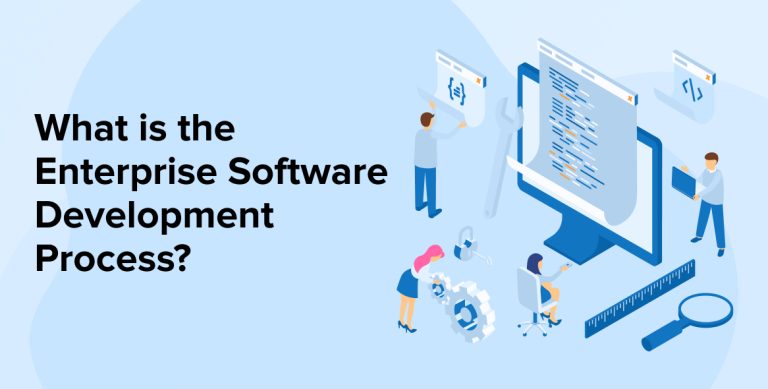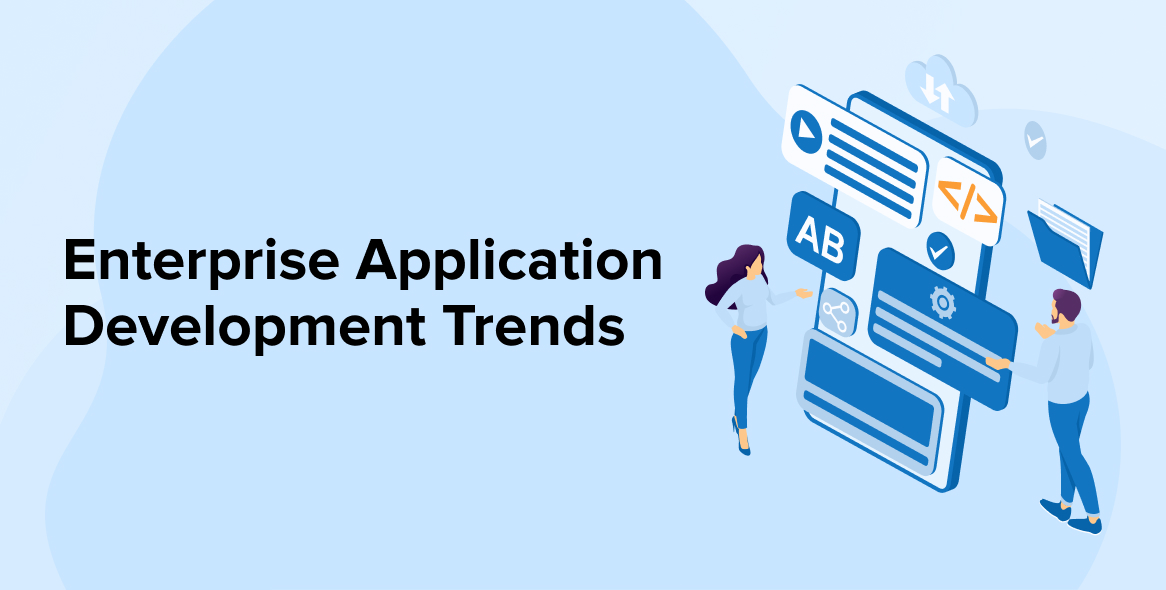
Enterprises are modernizing their software development processes and unleashing success in multiple aspects. The conventional way of doing business is upgrading and every business is adhering to change like never before. The change in operations is pushing businesses to develop a specific application that is tailored to their business needs. So, now the question is how are businesses supposed to take this development forward? In this blog, we are going to discuss all the noteworthy aspects which will help businesses understand the process of developing custom enterprise software solutions. So, let’s start with the understanding of why it is important for businesses to develop software for the enterprise, later we will be discussing the enterprise software development process.
1. The Importance of Enterprise Software Development Process
Developing a software application for your enterprise is capable of driving business profitability in manifolds. The primary reason businesses are drastically moving towards Software development is because it offers customization along with performance, productivity, and speed. Enterprises investing in custom software or mobile app development must have understood the benefits that it offers. Businesses can easily achieve reduced infrastructural costs, with automated and streamlined processes. Your organization will also be able to gain benefits with the enterprise software development process of better employee performance and increased business efficiency.
The growth of the global enterprise software market is unpredictable and with the fact that it is expected to reach 324.5 billion US dollars by 2024. This shows that enterprises must work on the tick of the clock if they want to cope with the changing market dynamics. Developing in-house is the first choice of businesses but it may cause them a fortune if things go wrong. On the other hand, if there are experts managing your enterprise software development, the complete responsibility is shared. The development process consists of several smaller processes which combine to create one enterprise application that ensures high performance, consistency, and agility.
Let us delve deeper into the roots of the phases of the enterprise software development lifecycle and understand how enterprise software is different from others:
1.1 The Planning Phase/ Requirements Phase
One of the most important stages in the creation of business software applications is planning. Prepare a roadmap that covers mission plans, schedules, and all the deadlines. Before initialization, it also estimates expenses, the budgets in terms of procurement specifications, and more. There are a few factors that play a vital role in making the planning phase successful. Although there are certain attributes that contribute efficiently to the process of making a software development process successful and profitable. These three important factors are Plans, plotting budgets and timelines, and finally procurement.
Project Plans
In the planning phase, we need to be determined about what we construct as a plan and whether it should be achievable and not desirable. Create a plan to develop enterprise software applications that focuses on a detailed fashion on each stage of software application development. The plan also includes the development tools and technologies, and programming methodologies to develop fully functional software applications.
Plotting Budgets and Timelines
Before you begin the project, double-check that the program is inexpensive and within your budget. Since software development can be expensive, it’s a good idea to plan ahead. Software development requires strict plans and realistic targets keeping in mind the team of enterprise software developers(experienced or amateurs) assigned to business needs. To save businesses losing on software development needs, it would be great if assign
Procurement for Performance
Be prepared with a list of the resources required, tools, emerging technologies, and other services, you’ll need to get started with software creation.
1.2 Analyzing Software Development Feasibility
After the research phase, it’s now time to analyze the enterprise software capability for business. So you can start scheduling meetings with the team to understand the timetable, and resources. and other software elements. During this process, you can ensure that the list of software specifications is taken into notice and made clear to all stakeholders. Gather as much information as possible and compile it into a structured document that has all of the necessary documentation. To determine the project’s needs holistically, use the following tricks:
- Perform complete research on the needs for the development of software.
- Understand the client’s existing business processes and how the software will make a difference.
- Do a survey and take answers from all stakeholders to understand their perspectives on app development.
- Allow interactions between developers and actual users to get real-time feedback.
1.3 The Software Design Phase
After analysis, we will now move towards the design of the application. Designing enterprise apps would be extremely easy now since you’ve worked out the specifications. The information you’ve collected will aid you in designing enterprise applications that meet all of the specifications. In this phase, you can easily create prototypes. These prototypes can be shared with all stakeholders for acceptance. Once all the stakeholders are on the same page, we can initiate the process of enterprise software development. The software’s architecture should be simple and easy to understand.
1.4 The Development Phase
Now comes the main stage, the foundation of all software architectural projects- The development stage. This is the implementation stage where all your planning gets converted into real-time fully functional applications. Once we accomplish the designing phase, the next step is initiated. Here the tools and program architecture are finalized, it’s time to start the development of the software. In this stage, the Project manager along with its team of developers will now start developing the project by coding, according to the specifications.
The development phase can be implemented in cycles and the final product can be delivered during the launch time. The coding process is overseen by the team of project managers or project management committees. It’s important not to press the production team to complete the development solutions without leaving any gaps in the process of developing software solutions.
1.5 The Testing Phase of Enterprise Software
This process of enterprise software development identifies all the loopholes and thus at regular intervals, there is testing applied at all phases. The process of developing software whether it is a mobile app or custom software is incomplete without the testing phase. Thus, it will always deliver a flawless or bug-free product. In the testing phase, we do not follow just one method but there are various testing methods that will scrutinize the process and reap the best of the software development solutions.
The types of software development testing include the following testing methods.
- Unit Testing – This test identifies modules one by one to ensure that each software unit performs as intended.
- QA Testing – Reduces the number of errors and crashes. Consequently, you’ll have a clean source code that’s simple to change as desired.
- Integration Testing – We can use this form of testing to identify flaws in the interaction of combined units. We run through all of the individual units that are put through their paces to ensure a seamless performance.
- UI Testing – This checks upon the user interface i.e the look and feel of the application. So this means how it will appear to users and how each of these users will interact with systems
- Performance Testing – The aim of this test is to identify and remove the software’s performance bottlenecks. So under the planned workload, developers test the speed, response time, reliability, resource consumption, and scalability.
- Security Testing – Enterprise software developers conduct security testing to identify any dangerous attacks, bugs, or dangers. It identifies security flaws that developers can address by coding.
1.6 The Deployment Phase of Enterprise Product
Ideally, this is the final stage of enterprise software development and its lifecycle. Once your enterprise development process has reached this stage then it means we have reached the finish line. After meeting the deadline of every sprint, we deliver the final product after testing rigorously and meeting the quality benchmarks through this phase. You can do the product launching through a manual approach or you can also deploy it through automated tools.
Once the deployment stage of the developed software solutions is over the next phase is to educate users on how to use the software applications.
1.7 Maintenance of Enterprise Software Development Project
Once you deploy the project, there are further concerns that may occur post-deployment. It is the duty of the customer software development company or enterprise software development company to address all the challenges and resolve them. Now that your app has a smooth launch, the application is ready to use. Testing is very important for an app’s performance. There is still space for alterations and the program will act in response to user input.
Regular tests will also reveal any program glitches or faults that are obstructing its efficiency. In addition to finding the glitches, it’s important to get them resolved.
2. Final Thoughts
Finally, every business has unique business requirements, and enterprise software development is an all-in-one solution for all types of complex business challenges. The development project of enterprise software can be related to developing a top-notch website or mobile application or any new-edge software development like AI, ML, or IoT. So these needs, if fulfilled by an expert, have the potency to deliver best-in-breed software results through their personalized software enterprise solution. From a progressive business outlook, will utilize the capability of the developer to develop enterprise-grade software and swiftly move step by step to accomplish success. Hence don’t think twice, it is imperative for every business to streamline their business environment, boost sales, enhance customer experience and get real-time analytics through enterprise management applications.




Must say it is a well written blog which clearly shows the importance of Software development methodologies to drive profitability and meet the complex challenges. As businesses are considering custom software development for their enterprise software,this one is a quick go-through for quick and hassle-free operations.